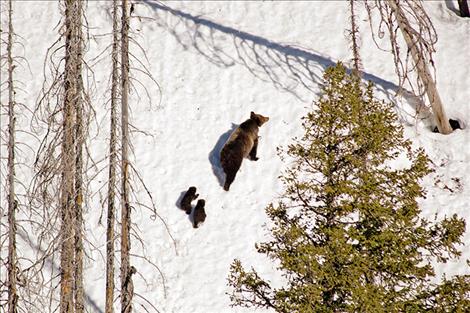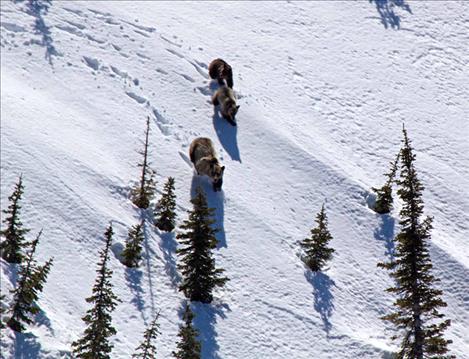Bears emerge from dens across Northwest Montana
Residents reminded to remove food attractants to avoid conflicts
Hey savvy news reader! Thanks for choosing local.
You are now reading
1 of 3 free articles.
News from Montana Fish, Wildlife & Parks
Bears are emerging from dens across northwest Montana and residents are reminded to remove food attractants from their properties to avoid conflicts.
Montana is home to grizzly bears and black bears that roam the mountains and valley floors from spring through late fall before denning in wintertime. Starting in mid-March, bears begin emerging and move to lower-elevation areas seeking food.
Montana Fish, Wildlife & Parks encourages residents to “Be Bear Aware” and remove attractants every spring by April 1.
“With this year’s above-average snowpack, bears are coming out of their dens and digging out from several feet of snow. There’s no place for them to go but down toward the valley floor to feed,” FWP Region 1 Grizzly Bear Management Specialist Tim Manley said.
Residents are asked to remove or secure food attractants such as garbage, bird feeders and bird seed. Chicken and livestock should be properly secured with electric fencing or inside a closed shed with a door.
In Montana, it is illegal to intentionally feed deer and other ungulates, mountain lions, and bears. This includes putting out grain, deer blocks, mineral blocks, sunflower seeds, meat scraps and other food. Feeding animals leads to food conditioning, which increases the chances of a conflict and the removal of that animal.
Montana’s spring black bear hunting season begins April 15. Hunters are required to pass a “black bear identification test” before purchasing a black bear hunting license. The free test is available online at http://www.fwp.mt.gov/education/hunter/bearID/.
Visit http://www.fwp.mt.gov for tips and tools on using bear spray, safe recreating and access to bear-resistant products. Contact FWP at 752-5501 to report any conflicts.
Common Bear Attractants
Chickens & livestock
Bird feeders & bird seed
Deer blocks
Garbage
Beehives
Fruit trees
Pet food
Barbecue grills
FAQ
Q. Are bears naturally aggressive toward humans?
A. No. Bears are usually solitary animals and act shy. They are typically non-confrontational unless they are surprised or feel threatened for themselves or their cubs. If you see a bear, stop and respect its need for space and try to leave the area.
Q. How good is a bear’s sense of smell?
A. A bear’s sense of smell is seven times greater than a bloodhound’s and hundreds of times more sensitive than a domestic dog’s. Bears can smell food more than a mile away.
Q. What do bears like to eat?
A. Grizzly bears are omnivores, so their diet can vary widely. They commonly eat seeds, berries, roots, grasses, deer, elk, fish, dead animals and insects.
Q. How many bears live in northwest Montana?
A. Northwest Montana is home to the largest population of grizzly bears in the lower 48 states with more than 1,000. The black bear population is much larger with approximately one bear per square mile.
Q. What are the safest ways to recreate in bear country?
A. Whether you are hiking, camping, mountain biking or hunting, you should always take safety precautions to avoid encountering a black bear or grizzly bear.
Always carry bear spray and know how to use it.
Never approach a bear. Respect its space and move away.
Travel in groups of three or more people whenever possible and plan to be out only in the daylight hours.
Make your presence known by talking or other means, especially when near streams or in thick forest where visibility is low. This can be the key to avoiding encounters. Most bears will avoid humans when they know humans are present.
Don’t approach a bear; respect their space and move off.
When camping, always secure food attractants, whether it’s in a bear-safe container or by hanging all food, trash and other odorous items well away from camp and at least 10 feet above ground and 4 feet from any vertical support. Keep a clean camp at all times. Never cook or eat in your tent.
When hunting, immediately field dress the animal and move the carcass at least 100 yards from the gut pile.
When mountain biking, slow speeds around sharp corners and in densely forested areas.

















